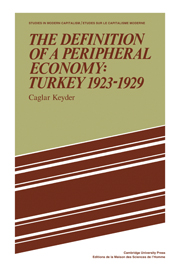Preface and acknowledgements
Published online by Cambridge University Press: 06 July 2010
Summary
This book, as will be evident to the reader, was originally a dissertation. When I first started working on Turkey, I wanted to study the etatist period of the 1930s. This period with its autarkic economic policy seemed attractive especially from the third-worldist perspectives of the 1960s. As I worked my way up from the Ottoman period to the 1930s though, I was detracted both by ideological estrangement from ‘non-capitalist’, nationalist models of development, and by the concerns of a different paradigm leading to a new set of research objectives. The 1920s seemed propitious from the point of view of these interests: it was a period of full integration into the world economy despite the constitution of an independent nation-state, and it exhibited an almost exemplary structure of a dependent economy. By establishing that political independence in itself did not imply an ‘independent’ path of economic development, my interpretation of the 1920s would constitute a revision of the dominant view on a little studied period. On the other hand, it was important to demonstrate that dependence consisted of a set of hierarchical relations within the world economy and rather than stagnation it engendered a particular kind of growth. Thus, my attention shifted to capture the structure of this growth and the nature of the mechanisms through which it was conditioned. This emphasis allowed me to illustrate some debated propositions about peripheral economic structures while describing the Turkish case.
- Type
- Chapter
- Information
- The Definition of a Peripheral Economy: Turkey 1923–1929 , pp. vii - viiiPublisher: Cambridge University PressPrint publication year: 1981

